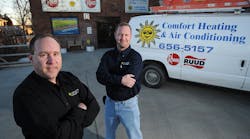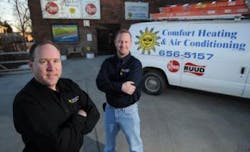Jeff Scherr, owner, Comfort Heating & Air Conditioning, LLC, Billings, MT, believes one of the most difficult challenges an HVAC business owner must confront is making the transition from “good craftsman” to “good businessman.” But for those owners who can finally “get out of the truck,” and focus on developing their business, it’s a giant step that will definitely take the business to new heights.
And, once you focus more on managing the business, be careful that you don’t ignore your approach to the HVAC sales process, where it all starts.
Scherr —who runs Comfort Heating & Air with his brother Tony, and their wives, father Tom, and brother in-law, is guiding the 30-year-old residential/commercial HVAC business started by their dad to one of its most successful periods — believes it’s essential to master the art of the HVAC sale.
I spoke to Scherr recently about how he goes about selling to Comfort Heating & Air’s residential customers.
Scherr believes good, effective selling is essentially a simple process that comes down to, “showing up, being extremely honest with prospects, and offering them choices.”
If you think “showing up” as an element in this company’s success seems a little too simple, Scherr will tell you he’s constantly surprised by the number of competitors who don’t return calls from prospective clients.
“I understand that people are busy, but these homeowners are willing to spend hard earned cash, and contractors aren’t returning phone calls to even make an appointment to get into the house,” he marvels. “To get a sale, it might be a good idea to return the phone call and show up for the appointment.”
Knowing and Working with People
HVAC is a people business, with customers of all personality types. Scherr has found that prospective customers can be different in every way, even in how they choose to provide information and review their comfort options. While the contractor holds a couple of high cards as the comfort expert, a controlling, “Type A” prospect still holds a better hand. The contractor who can understand human nature best, and work with all types of people, wins the job.
“You can’t use any single method for an in-home visit, comfort system proposal, energy survey, or energy audit,” he says. “You first have to pick up clues about the prospect’s personality in the initial phone call. When you set appointment you can gain clues as to what the customer will be open for. You have to use those clues to figure out what the person wants and may respond best too.”
Later, during an initial home meeting, Scherr gathers information in a way a homeowner understands or is most comfortable with.
“Some fit into the classic stereotype of wanting a lot of privacy. Others want to sit down with coffee before you even look at the furnace. They want to get a feel for you, do you have a family, and so forth. That’s where I tout that we’re a 30-year, second generation business. My wife answers the phone, my dad still works with us, and we have 18 technicians who are part of our ‘family.’ They want to establish that before you get into the mechanics of the job.
“Others are more to the point: ‘Give me a bid and leave. When will you be here, what will they do how long will it take?’
“Some don’t mind if you come in with the ipad and laptop, conduct a survey, and talk about all the comfort and air quality things, basic system selling approaches. Others just want you to walk in, measure it up, and leave.” Fewer than 5% of Scherr’s initial meetings turn into long conversations. “I haven’t drawn up a proposal in a home in two or three years,” he says.
For the briefest meetings, Scherr asks three questions:
- ‘What would you like in an HVAC system?’
- ‘What issues have you been having?’
- ‘What are your expectations?’
“However, if you discover over the phone that the woman of the house wants lots of information, be prepared for a longer meeting with lots of questions, be flexible? It is important to have a great toolbox with different selling methods to serve all types of personalities ”
Whichever scenario develops, Scherr is always alert to make note of things he sees during the visit, and bring them up when the time is right.
“If I’m in a 1,250 sq. ft. home that has an existing older oversized 150,000 BTUH furnace, I can have a discussion about short-cycling, lack of comfort in cold basements, or issues facing multi-level homes, something that allows me another five or 10 minutes, because I’ve identified an issue. Normally, their response is, ‘And what can you do to solve that for me, Jeff?’ “That’s when I can talk about two-stage or variable speed systems. You can’t push them, but you can definitely guide them into allowing you more time."
Scherr begins with a binder of basic information. If they need more information, he gets it out of his truck. He has a leave behind card with some options and company information, or may leave his I-pad running with a video or other information for the client to review while he is at the truck. This also allows couples to discuss things for a moment.
When completed “I’ll leave information on our Comfort Care Plan, and possibly brochures on equipment and other items we discussed. I always ask the homeowner how they’d like to receive the final proposal, and I always ask to be allowed to come back to talk it over. Some just want an email, but I’ll also send a packet via the regular mail. The packet contains the proposal first and foremost, an easy reference letter on the different equipment features, brochures, additional items like indoor air quality options and a copy of the home’s load calculation.
Time to Compare & Contrast
During the interim, homeowners have a chance to talk to other contractors, which Scherr says can work to his benefit, when the others don’t measure up, don’t or cannot provide what the customer wants or has a bad presentation. He says 30 to 40% of prospects are looking at two or three estimates. Another 10 to 15% are just fishing the market for the lowest price. “They’re calling everybody. They might have five to 10 contractors come in. In this region, more than 50 HVAC contractors are serving a region of less than 150,000 people. Some are strictly commercial companies, and some only serve outlying areas, so there’s about 30 residential contractors for the consumer choose from. That includes the guy working out of his truck, to larger companies like ours.
“After they’ve met with other contractors, I get to come in and sit down to discuss features, and the things they want. Then, the pricing discussion happens.”
When it comes to offering solutions, whether at the first or second meeting, Scherr always provides a variety of options because . . .guess what?…people want choices.
“In the end, they don’t always choose the most expensive system, but they aren’t automatically driven to buy the least expensive system, either,” he says. “The market has tightened up, people are more money-conscious, and more willing to spend more, if the return is greater. They understand that the return on their investment in cash and energy savings is one thing, but they also want comfort. Some of them have lived in their homes 20 or 30 years and have never truly been comfortable. I’m transparent about the cost, and about what they’re going to get for that money they spend.”
Although he sends proposals by email and snail mail, Scherr always requests that he get time for a second, in-person visit, to explain those proposals and get the work scheduled. Mailed information includes a copy of the load calculation, an easy reference sheet that explains 85% and 95% furnaces, single and multi-stage technology, variable speeds, ECM motors, two-stage air conditioners, and heat pumps.
The “final” proposal meetings are focused on a “good/better/best” set of options, that pretty well cover the company’s entire line of product offerings from Rheem and Armstrong Air.
“We still deal with a lot of 80% furnaces in our market, so I continue to provide pricing on an 80% single-stage furnace, an 80% two-stage, the 95% AFUE furnaces, variable speeds, and in certain applications, modulating units.”
Comfort Heating & Air is a Rheem Recognized Top Contractor, members of the Service Roundtable, Mitsubishi Diamond Contractors, and its technicians persue North American Technician Excellence (NATE) certification.
Comfort Heating & Air Conditioning, LLC enjoyed their best retrofit year ever in 2012 residential sales of furnaces and air conditioning systems with about a 20% increase over previous years, thanks to an extremely hot summer, and homeowner tax rebates for new HVAC system installations.
“People’s environmental thinking is changing, They wonder why they’d want to put in an 80% furnace when a 95% is so much more efficient and economical, same with higher SEER ac units. In the last year, on practically every workday, we’ve had at least one retrofit.”
Trade School Crisis
The only thing holding Comfort Heating & Air from growing much faster is the lack of trained workers who are ‘van ready,’ because fewer and fewer students are entering the industry. For example, the two-year technical college in Billings has closed its HVAC program. Scherr believes the lack of enrollment in electrical and HVAC trade schools is nearing a “dangerous” level.
“Nowadays, they go through high school with the expectation of attending college. They think they have to get into computers, or they won’t be able to compete. The high schools have failed in that they aren’t teaching people about the trades, HVAC, welding, auto mechanics, electrical, on and on. There’s a huge labor world out there that isn’t getting any mention.
“Eventually, due to extreme shortage of tech, our technicians will be able to say that they can get a job anywhere at $100/hour. Labor shortage can demand higher wages to keep employees. If I’m paying a guy that much , it becomes a $200 service call for me to walk in the door.” Most customers will not be able to afford the higher service rates. This is not a good situation for the consumers or the service companies.
Judge Not
One of Jeff Scherr’s cardinal rules is, “Don’t Prejudge a Customer.” To prove his point, he offers this story:This past November, he received a call from an elderly woman looking for a new air conditioning and heating system.
When he arrived, Scherr says she was very guarded, almost afraid to speak. But then she spoke up, and told him she wanted:
- a digital thermostat
- a 95% AFUE furnace with an ECM motor
- a 16-SEER, two-stage heat pump.
“Then,” Scherr recalls, “she asked me if that was okay. I said, ‘Why wouldn’t it be okay?’ and she said two other contractors told her someone her age doesn’t want a complicated digital thermostat. Two others said she wouldn’t live long enough to realize the payback on the higher-endsystem, and one said at her age, she probably didn’t want a high-tech system that she wouldn’t understand.”
Scherr was floored.
“Those guys all offended this lady. I said, ‘Ma’am, first and foremost, I’m going to give you what you want. Second, you’ve done your research, and that makes me believe you’re technologically aware, and can handle what I sell you.
And third, if we install it right and show you how to use it, I don’t care what age you are,” you’ll be able to operate it.’
“She bought the top-end system, a 95% variable speed furnace, 16-SEER, two- stage heat pump, electronic air cleaner, humidifier, and our Comfort Care plan. And I’ve gotten five or six referrals from her friends.
“She had told the other contractors what she wanted, and they were trying to talk her out of it.”
Judge not.











